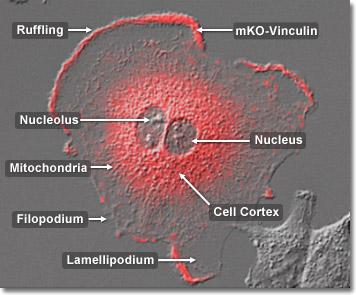Focal adhesions are large assemblies of macromolecules through which the cell can anchor itself to the extracellular matrix. In general, the cell connects with the surrounding substrate through the protein integrin, which links to actin filaments, the cytoskeletal components that shape the cell structurally. The connection of focal adhesions to the world outside makes them ideal for transmitting mechanical forces and signals containing information about the surrounding conditions. In the digital video presented above, several rabbit kidney epithelial cells (RK-13 line) expressing monomeric Kusabira Orange fluorescent protein fused to human vinculin are tracked as they slowly progress along the coverslip. Note the high level of labeled vinculin that resides in the lamellipodia, which extend and retract continuously throughout the video.
Video 1 - Run Time: 60 Seconds
Video 2 - Run Time: 56 Seconds
Video 3 - Run Time: 57 Seconds
Video 4 - Run Time: 57 Seconds
Video 5 - Run Time: 55 Seconds
Video 6 - Run Time: 58 Seconds
Video 7 - Run Time: 63 Seconds
Video 8 - Run Time: 58 Seconds
Video 9 - Run Time: 54 Seconds
Video 10 - Run Time: 55 Seconds
Video 11 - Run Time: 59 Seconds
Once a cell is attached to the substrate through focal adhesions, it is free to change shape, divide and differentiate, during which the cell does not usually produce any more adhesions. Cells can send and receive signals to and from the extracellular matrix through focal adhesions. Transmembrane proteins, called integrins, bind to extracellular molecules, such as fibronectin, and link them with an inner cluster of proteins connected to actin filaments, thereby anchoring the cell internally to the surrounding matrix. Chemical and mechanical signals, which influence the behavior of the cell, are sent along this interconnected protein network. Mechanical tensions between the outer matrix and the transmembrane-integrin molecular complex, along with a series of phosphorylation reactions, evoke the integrin group to mature into a full focal adhesion that sends and receives vital biochemical and mechanical messages. In the digital video presented above, a single rabbit kidney epithelial cell (RK-13 line) expressing monomeric Kusabira Orange fluorescent protein fused to human vinculin is tracked as it slowly progresses along the coverslip.

In the cytoplasm, focal adhesions must bind to actin filaments for anchorage to the surrounding medium through a group of proteins known as ERM proteins, named for the principle elements: ezrin, radixin, and moesin. These proteins act as membrane linkers that contain two distinct domains: one end must bind to an integral membrane protein while the other binds to actin structures within the cell. When the anchoring proteins are activated, both domains are exposed and ready for bonding whereas in the inactive state, the molecule folds up therefore deactivating both domains. Most likely, the change in activation states is stimulated by a phosphorylation process of the ERM proteins. In the digital video presented above, a single rabbit kidney epithelial cell (RK-13 line) expressing monomeric Kusabira Orange fluorescent protein fused to human vinculin is tracked as it slowly progresses along the coverslip.